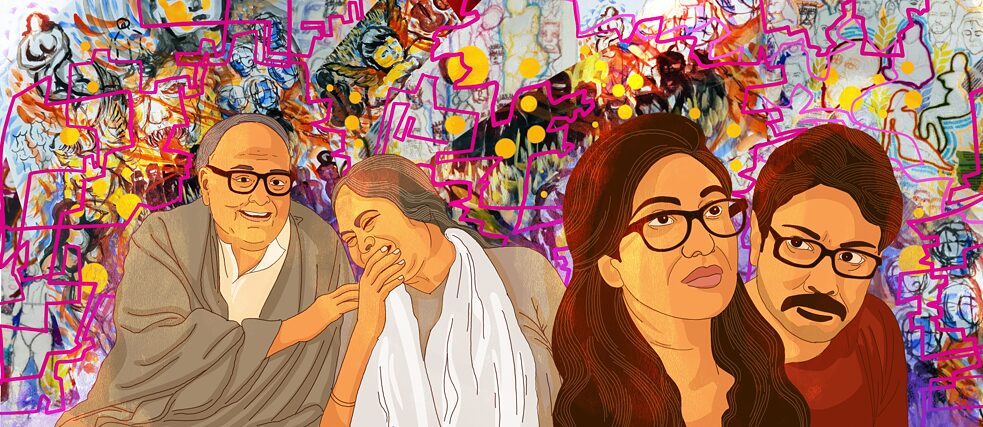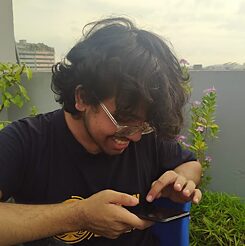By Mashaekh Hassan
Rewatching and reassessing Belasheshe and Praktan: a confounded feminist take

Considering the debate regarding the rigidification of the gender roles being a colonial imposition, the exaggerated romanticization of the sustenance of marriage solely for the sake of marriage itself is mostly backed up by some oral references to the “pure” Bengali values, norms, and culture.
I vaguely remember some of the conversations where I endorsed Praktan (2016) over Belaseshe (2017), emphasizing on the seemingly feminist elements. More precisely, the elements that aligned with my understanding of feminism which, by the way, was and still is under construction. Given the portrayal of a passionate, career-oriented woman alongside a traditional housewife, Praktan (2016) felt like an unconventional production challenging both patriarchal and pseudo-feminist paradigms. In other words, choosing to be a housewife is just as valid of a choice as prioritizing career; something that is portrayed in Praktan. As an 11th grader and an emerging feminist back then, I found the film quite revolutionary. I was pleasantly surprised to see the number of people who admired Praktan, thinking an anti-patriarchal wave was approaching. Took me a while to realize the strict distinction between mere portrayal and representation. Quite recently, a clip from Praktan got viral on Facebook yet once again. The scene showed a traditional woman lecturing an “independent” woman on the importance of sacrifice in a marriage. Seeing the comment section mostly glorifying the traditional housewife’s wisdom, I quite quickly realized that the “other” woman in this case has been used to highlight the subjective superiority of the value-abiding, culturally appropriate, feminine woman.
Co-directed by Shiboproshad Mukherjee and Nandita Roy, Belaseshe (2015) and Praktan (2016) are two famous Bengali movies portraying the Calcutta-based Bengali middle-class ideas and ideologies surrounding the institution of marriage.
Within the sub-continental context, regardless of religion, marriage is considered sacred, and hence, a mandatory rite of passage. The sustenance of marriage is given so much importance that even the idea of mutually decided divorce is stigmatized.
Considering the debate regarding the rigidification of the gender roles being a colonial imposition, the exaggerated romanticization of the sustenance of marriage solely for the sake of marriage itself is mostly backed up by some oral references to the “pure” Bengali values, norms, and culture. Not applicable to all the cases but the negative aspect of an abusive marital relationship is barely considered a reason for breaking up. Even though it may sound like a blanket statement, despite holding a lot of truth, staying in marriage itself is considered so important that the imbalanced power dynamics between a man and a woman are considered legitimate and the sacrifice from the wife’s end is taken for granted.
As Debarati Dhar puts it, Belaseshe (2015) attempted to depict a positively different kind of picture of boredom that sets into marriages. It showed a refreshing version of a wife as a homemaker who is fulfilling the traditionally feminine roles with an overarching approval of the societal expectations of the binary genders. Likewise, quite stereotypically the film shows that the true love from the husband's end lies in recognition of his contributions to his wife. The wife is seen to be eating her husband’s leftover foods, respecting her husband in every way she is socio-culturally expected to. Quite different from Aarti, Sudipa is not as conventional. Dichotomously, the contrast between a conventional and non-conventional wife has been shown through the differences between Sudipa and Malini, as visualized in Praktan (2016). In both movies, the husband figure, in the end, is shown as a changed person in terms of their ideas and actions. In none of the creations, divorce was depicted as a valid option. Although no visibly violent gesture from the husband’s end was depicted in Belaseshe, unlike the case of Praktan, the idea of continuing the marriage was prominent. The only point of justification in Praktan is that the ex-husband did not continue to be as violent and toxic as he was in the past.
Setting the journey of personal growth aside, the breaking of marriage has been shown as an undesirable event, sacrificing something as a mandatory benevolent act. Nicely fitting into the capitalist therapeutic models of ‘re-normalization’ people would be able to recognize the significance of communication in a marriage.
In an interview conducted by Deb Roy (2019), Nandita Roy revealed: "The concept of middle class had been prominent because the life of urban middle class has come up subconsciously in our films because that world is more known to us.” It may not be wrong to hypothesize that the indicated kind of middle-class stems from a heterogeneous way of viewing the entity/stratum. Based on my occasional ganders at comment sections of clips from such movies and my confounded feminist lens, I see no proper representation of different kinds of women making different choices within a conventional, patriarchal society. Now, the filmmaker may or may not plan to manipulate people’s thought processes in a certain way. Call it an unintended consequence but considering the hegemonic nature of conventional values, movies like Belaseshe and Praktan, although they cover the unpleasant aspects of marriage, send a message that is in favor of the conventionally acceptable paradigm.
Bibliography
- Deb Roy, L. (2019, August 13). Why Bengali Films Of Nandita Roy And Shiboprosad Mukherjee Are Mostly On The Urban Middle Class. Outlook India. Retrieved July 12, 2022, from https://www.outlookindia.com/website/story/entertainment-news-why-bengali-films-of-nandita-roy-and-shiboprosad-mukherjee-are-mostly-on-the-urban-middle-class/335682
- Dhar, D. (2021). Representation of Ageing People in Bengali Cinema. The Discussant, 9(1), 43-51. https://www.crdj.in.
- Mukherjee, S., & Roy, N. (Directors). (2015). Bela Seshe [Film]. Windows Production.
- Mukherjee, S., & Roy, N. (Directors). (2016). Praktan [Film]. Windows Production.
AUTHOR
 © Mashaekh Hassan
Mashaekh Hassan graduated with a Bachelor of Social Science (BSS) in Anthropology from Brac University. He is an avid reader and a passionate writer and aspires to join academics in the future. His areas of interest include society, culture, religion, and gender.
© Mashaekh Hassan
Mashaekh Hassan graduated with a Bachelor of Social Science (BSS) in Anthropology from Brac University. He is an avid reader and a passionate writer and aspires to join academics in the future. His areas of interest include society, culture, religion, and gender.Illustrator
 © Sadia Akter
Hi, This is Sadia Akter. I've completed my graduation from the department of Graphic Design, University of Dhaka. I'm pursuing my post-graduation from the same department. I've always thought of myself as having a soul that is free and vibrant, like a bird. As a child I've always felt a strong artist self within myself, it got a new direction after I came to study here in the Fine Art's Faculty. I'm always exploring myself and searching for inspiration from everything around. I love to introduce my soul to new forms of art like theatre and performance studies. I'm a Children's book illustrator and I've worked for clients all over the world. I have a wide range of work areas where I'm expanding my wings each single day.
© Sadia Akter
Hi, This is Sadia Akter. I've completed my graduation from the department of Graphic Design, University of Dhaka. I'm pursuing my post-graduation from the same department. I've always thought of myself as having a soul that is free and vibrant, like a bird. As a child I've always felt a strong artist self within myself, it got a new direction after I came to study here in the Fine Art's Faculty. I'm always exploring myself and searching for inspiration from everything around. I love to introduce my soul to new forms of art like theatre and performance studies. I'm a Children's book illustrator and I've worked for clients all over the world. I have a wide range of work areas where I'm expanding my wings each single day.